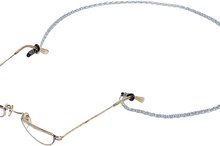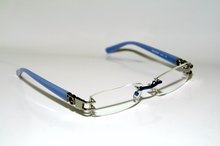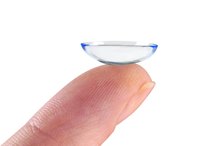How to Compare Varilux and Shamir Progressive Lenses
By the time you're in your 40s, you probably will notice some trouble trying to read small print. The Ohio State University Medical Center website notes that presbyopia, a reduced ability to see near objects, eventually affects everyone by age 50 1. Choosing the right progressive lens for presbyopia is challenging; the variety of available features is overwhelming. Also called no-line or invisible bifocals, progressive lenses like Varilux and Shamir have specific qualities that set them apart. Comparing the two types of lenses helps you to decide which no-line bifocal will work best for your situation.
Research and learn how progressive lenses work. Progressive lenses or PALs are designed to give a natural type of vision with a smooth transition from distance to near, but all PALs have a small area of blur where the power changes from distance to close. Progressive lenses are available in two main styles. One style has a wider corridor, also called a channel, which is the middle area that helps when using the lenses more for reading at arm's length. This would include the dashboard of a car or a computer screen that sits on a desk.
The other type has a wider reading area in the bottom of the lens and is better for close detail work and tiny print.
The Best Frames for Progressive Lenses
Learn More
Go to the Shamir website and review the different style of lenses and also look through their Vision 101 educational information. As of 2010, Shamir makes nine different styles of PALs, including a custom-made style lens that improves optical accuracy. Research the features of the Genesis, Piccolo, Attitude, Office, Element, Spectrum, Creation, Freeform and Autograph lenses. Each style helps with different types of vision needs and some work better with different types of prescriptions. The Piccolo works better for smaller frames and the Genesis lens is designed for enhanced peripheral vision. The Creation progressive is a flatter lens used for minimal distortion. The Shamir Office is designed with a smaller reading area and a wider mid-range lens for people who read more at a distance, such as artists, mechanics, and musicians. The Autograph and other style of progressive lenses use the newest technology to custom-design lenses based on your specific prescription requirements. A pair of Shamir custom-made lenses retails for approximately $300 to $700, depending on the prescription, additional features like tinting or other coatings and where they are purchased.
Visit the Varilux website and read through its frequently asked questions, product descriptions and use the Varilux experience to try different progressive lens styles. As of 2010, Varilux makes seven different progressive lenses, and some of the styles are available with custom-made features like Shamir lenses. The Physio progressive is comparable to High Definition television. The lenses provide what Varilux refers to as "High Resolution" vision and have crisper detail. The Comfort progressive lenses provide a natural vision and work well for seeing digital devices like cell phones or e-readers more clearly. The Ipseo is a custom-designed lens that has image stabilizers. Varilux has a line of progressives called Occupational that incorporate specific needs into lens design. The Road Pilot is a good progressive for someone who does a lot of driving, the Sport lens works well for an active lifestyle and the Computer lens is a good progressive for office work. Varilux lenses cost approximately the same as Shamir lenses when comparing similar features. Varilux lenses retail for approximately $300 to $700 a pair.
Types of Bifocal Lenses
Learn More
Visit a local optical retail office or eye care practitioner and ask to see demonstrations of Varilux and Shamir lenses. Many opticians and optometrists have educational materials and hands-on tools that allow you to explore different features of no-line lenses at no charge.
Related Articles
References
- Ohio State University Medical Center: Refractive Errors
- Alvarez TL, Kim EH, Granger-donetti B. Adaptation to Progressive Additive Lenses: Potential Factors to Consider. Sci Rep. 2017;7(1):2529. doi:10.1038/s41598-017-02851-5
- Han SC, Graham AD, Lin MC. Clinical assessment of a customized free-form progressive add lens spectacle. Optom Vis Sci. 2011;88(2):234-43. doi:10.1097/OPX.0b013e31820846ac
Writer Bio
Beth Richards, a freelance writer since 2002, writes about health and draws from her 25 years as a licensed dispensing optician. She has authored several books, writes for national magazines including "Country Living" and "Organic Family" and is a health and wellness features writer for several publications. She is earning a Bachelor of Arts in English from the University of Maryland.








